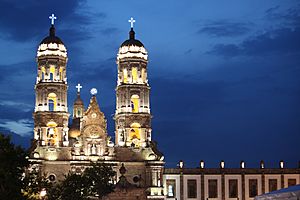Basilica of Our Lady of Zapopan facts for kids
Quick facts for kids Basilica of Our Lady of Zapopan |
|
|---|---|
| Basílica de Nuestra Señora de Zapopan | |

The Basilica of Our Lady of Zapopan 2019
|
|
| 20°43′17″N 103°23′32″W / 20.7213°N 103.3923°W | |
| Country | Mexico |
| Denomination | Roman Catholic |
| History | |
| Dedicated | 17 March 1866 |
| Architecture | |
| Architectural type | Baroque |
| Administration | |
| Archdiocese | Roman Catholic Archdiocese of Guadalajara |
The Basilica of Our Lady of Zapopan (Spanish: Basílica de Nuestra Señora de Zapopan) is a famous church and abbey in Zapopan, Jalisco, Mexico. It was built by Franciscan monks in the 1600s.
This church is one of the most visited holy places in Western Mexico. It holds a special wooden statue of the Virgin Mary. This statue is very old, coming from Spain in the 1500s. The building also has a museum called the Huichol Museum.
Contents
The Virgin of Zapopan: A Special Statue
The statue of the Virgin of Zapopan is very important to many people. She is also known as Our Lady of Expectation. People sometimes call her La Generala or the Zapopanita.
In 1734, she was named the protector against storms and lightning. The statue travels to Guadalajara each year. It stays there from June 13 to October 12.
After Mexico became independent in 1821, the Virgin was named the protector of the state of Jalisco. She received a special honor called a Canonical Coronation on January 18, 1921. During this event, she was given the keys to the city of Guadalajara.
The Romería: A Grand Pilgrimage
The Romería of the Virgin of Zapopan is a huge yearly event. It is a long walk, or pilgrimage, from the Guadalajara Cathedral to the Basilica of Zapopan.
This pilgrimage is one of the three most important in Mexico. It is almost as big as the pilgrimages for the Virgin of Guadalupe and the Virgin of San Juan de los Lagos. The Romería of the Virgin of Zapopan covers about 8 kilometers (5 miles).
Every year on October 12, before the sun rises, a large procession begins. Many people join, including Catholic followers, traditional dancers, and priests. They carry the statue of the Virgin Mary from the cathedral to the basilica. More than 1,000,000 people often join this procession. The festival ends with a special church service, called a mass, held outside the basilica. There are also traditional dances and fireworks in the evening.
Because of its cultural importance, UNESCO added the Romería—pilgrimage to its List of the Intangible Cultural Heritage of Humanity in 2018. This means it is recognized as a very special tradition that should be protected.
History of the Basilica and Abbey
Long ago, different groups of native people lived in the Zapopan area, starting around the 1100s. In 1530, Spanish explorers led by Nuño Beltrán de Guzmán took control of this land for New Spain. Soon after, missionaries arrived. In 1541, the town of Nuestra Señora de la Concepción de Tzapopan was founded. A local story says that the Virgin Mary helped bring peace between the Spanish and the native people during battles. She supposedly convinced the local population to stop fighting and become Christians.
The main construction of the abbey and basilica started in 1689. Over the years, the building was changed and added to many times. The front of the church has a large entrance area. It features beautiful Spanish Baroque designs with Ionic columns, carved pictures, and big urns on stands.
The main altar inside the church is made of white marble from Italy. The stand for the Virgin's statue was made from cypress wood by local artists in the 1600s. The abbey also has rooms for the priests and quiet gardens for thinking. The basilica is used as a training center for Franciscan monks.
Another local story says that the Virgin helped the people fighting for Mexico's independence from Spain in 1821. In 1979, Pope John Paul II visited the church, which was a very special event.
The basilica is a great example of 17th-century colonial Baroque architecture. It is surrounded by other old Spanish colonial buildings. These include the Chapel of Nextipac and the Chapel of Santa Ana Tepetitlán, which were also built by Franciscans. There are also buildings from later in the 1600s, like the Neoclassical style Church of San Pedro Apóstol and the Municipal Palace.
Art and Museums at the Basilica
The church has many beautiful artworks, including paintings and sculptures.
- A oil painting of Juan Cruz Ruiz de Cabañas y Crespo, who helped support the church.
- The famous statue of the Virgin, made by local artisans from Michoacán in 1541.
- A painting called "The Holy Family" by Victoriano Acuña (from 1832).
- In the church's entrance area, called the atrium, there are two bronze statues. One is of Fr. Antonio de Segovia, and the other is of Pope John Paul II.
Next to the basilica is the Huichol Museum. It has a permanent display of art from the Huichol, Tepehuan, and Cora people. There is also a Museum of the Virgin of Zapopan on the north side of the basilica, near where the Virgin is honored.
Images for kids
See also
 In Spanish: Basílica de Zapopan para niños
In Spanish: Basílica de Zapopan para niños
- Baroque architecture in Mexico
- List of basilicas
- List of Christian pilgrimage sites




